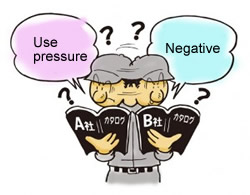Hose and Coupling Knowledge Base
If You Register to Become a Web Member, We Will Send You the Latest Information on Hoses and Coupling.
How to Read Catalog Specifications, Part 2 – Negative Pressure+B10

When winter approaches, high pressure gradually gathers in Japan in the west and low pressure gathers in the east. This typical weather pattern brings many days of favorable weather on the Pacific side of the country, while the side on the Sea of Japan receives cloudy weather and snow.
Whether high pressure or low pressure, the unit used for these meteorological phenomena is hectopascals expressed in positive numbers. In contrast, have a look at the Toyox hose catalog. The use pressures range from -0.1 to 1.5. What does a negative pressure mean?
To give an example, when a tank with a fluid in it is placed at a high position and the fluid is flowed to a tank at a lower position, gravity pushes the fluid to create pressure that can be measured. The pressing force presses on the hose as well as on the fluid, of course. The use pressure is a numerical value that indicates the degree to which the hose can withstand that force. The pressing force is represented as a positive number.
In the reverse situation, where a fluid is transferred from the lower tank to a higher tank, it is like drinking a milkshake through a straw. That suctioning force shows up as negative pressure. It has a pulling effect on the inside of the hose, rather than the outside. Ordinary horses do not have reinforcement or have braided threads, which provides strength for a force from inside, but not resistance to a suctioning force. To provide that, coiled metal or plastic reinforcement is used to provide shape retention and withstand suctioning.
It may be noted that "low pressure" and "high pressure" are not in relation to a standard, but are relative measurements.
Archive
How to Cut Steel-Wire-Reinforced PVC Hose
Does Electricity Conservation Increase Condensation?
Why Do Hoses Leak & Disconnect?
Can PVC & Other Plastic Hoses Be Used for Fuel Gas & Kerosene?
How to Read Catalog Specifications, Part 4 – Are Hose Sizes Random?
How to Read Catalog Specifications, Part 3 – Minimum Bend Radius
Beware of Static Electricity on Hoses
How to Read Catalog Specifications, Part 2 – Negative Pressure+B10
About REACH, RoHS, Endocrine Disruptor & the Food Sanitation Act
How to Read Catalog Specifications, Part 1 – Use Pressure
How to Avoid Damage Caused by Ultraviolet Rays
The Dangers of Hose Condensation
Why Transparent Hoses Become Cloudy
Leaks & Disconnections Due to Mismatched Couplings & Hoses
Causes & Solutions for Leaks & Disconnections
The Benefits of the Right Hose for the Situation (2)









